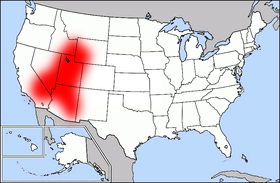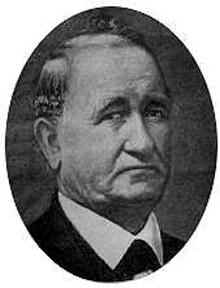Felt is a non-woven cloth that is produced by matting, condensing, and pressing fibers.
Contents
Felt may also refer to:
Felt is a non-woven cloth that is produced by matting, condensing, and pressing fibers.
Felt may also refer to:

Nauvoo is a small city in Hancock County, Illinois, United States, on the Mississippi River near Fort Madison, Iowa. The population of Nauvoo was 950 at the 2020 census. Nauvoo attracts visitors for its historic importance and its religious significance to members of several groups: The Church of Jesus Christ of Latter-day Saints; the Community of Christ, formerly the Reorganized Church of Jesus Christ of Latter Day Saints (RLDS); other groups stemming from the Latter Day Saint movement; and the Icarians. The city and its immediate surrounding area are listed on the National Register of Historic Places as the Nauvoo Historic District.

Adam-ondi-Ahman is a historic site in Daviess County, Missouri, about five miles south of Jameson. It is located along the east bluffs above the Grand River. According to the teachings of the Church of Jesus Christ of Latter-day Saints, it is the site where Adam and Eve lived after being expelled from the Garden of Eden. It teaches that the place will be a gathering spot for a meeting of the priesthood leadership, including prophets of all ages and other righteous people, prior to the Second Coming of Jesus Christ.
Music has had a long history in the Church of Jesus Christ of Latter-day Saints, from the days in Kirtland, Nauvoo, and the settlement of the West, to the present day. In the early days of the Church, stripped-down Latter-Day Saint folk music, which could be sung without accompaniment due to the lack of instruments in Utah, was popular. In the 19th century, the Mormon Tabernacle Choir was created and began touring, while musicians began writing devotional and praise music with a Latter-Day Saint influence, paralleling the success of Christian Contemporary Music. Several organizations have existed and do exist to promote these artists, such as Deseret Book and the now-defunct Faith-centered Music Association. Starting in the late 20th century and to the present day, Latter-Day Saints have been increasingly involved in modern popular music in America and elsewhere in the World.

The Mormon corridor refers to the areas of western North America that were settled between 1850 and approximately 1890 by members of the Church of Jesus Christ of Latter-day Saints, who are commonly called "Mormons".

Jonathan Golden Kimball was a leader of the Church of Jesus Christ of Latter-day Saints, serving as a member of the First Council of the Seventy from 1892 until his death in 1938. He is considered one of the most colorful and beloved of the church's general authorities. In the years since his death, "Uncle Golden" has become a near legendary character among church members, possibly comparable to what Will Rogers or Mark Twain are to the general American public.

Eastern Idaho is the area of Idaho lying east of the Magic Valley region. It is generally understood to include: Bannock, Bear Lake, Bingham, Bonneville, Butte, Caribou, Clark, Custer, Franklin, Fremont, Jefferson, Madison, Oneida, Power and Teton Counties. Much of the region is in the Mormon Corridor, and the Church of Jesus Christ of Latter-day Saints plays a major role in the lives of the region's residents.

The Lubbock Texas Temple is the 109th operating temple of the Church of Jesus Christ of Latter-day Saints.

Dimick Baker Huntington was a leading Indian interpreter in early Utah Territory. He commissioned a 22-foot-long missionary panorama of C. C. A. Christensen to use in his presentations of the gospel to the Native Americans in 1871. That missionary panorama is housed in the Church History Museum of the Church of Jesus Christ of Latter-day Saints.

The Church of Jesus Christ of Latter-day Saints in Idaho refers to the Church of Jesus Christ of Latter-day Saints and its members in Idaho. Rexburg, Idaho is home to Brigham Young University–Idaho. Idaho has the third most church members of any U.S. state, and the second-highest percentage of members. The LDS Church is the largest denomination in Idaho, with the largest presence in Eastern Idaho.

The Church of Jesus Christ of Latter-day Saints in Wyoming refers to the Church of Jesus Christ of Latter-day Saints and its members in Wyoming. The church's first congregation in Wyoming was organized in 1877. It has since grown to 67,454 members in 172 congregations.

The Church of Jesus Christ of Latter-day Saints in Oregon refers to the Church of Jesus Christ of Latter-day Saints and its members in Oregon. Oregon has the 9th most members of the Church of any U.S. state. Members have had considerable influence in the state throughout its contemporary history and many influential Mormons have come from Oregon including Senator Gordon H. Smith.

The Church of Jesus Christ of Latter-day Saints in Missouri refers to the Church of Jesus Christ of Latter-day Saints and its members in Missouri. The official church membership as a percentage of general population was 1.14% in 2014. According to the 2014 Pew Forum on Religion & Public Life survey, roughly 1% of Missourians self-identify themselves most closely with The Church of Jesus Christ of Latter-day Saints. The LDS Church is the 8th largest denomination in Missouri.

The White Horse Prophecy is the popular name of an influential but disputed version of a statement on the future of the Latter Day Saints and the United States. It was given by Edwin Rushton in about 1900, and supposedly made in 1843 by Joseph Smith, Jr., the founder of the Latter Day Saint movement.
Joseph Coulson Rich was an American, politician, judge, and early settler of the Idaho Territory.
The name of the Church of Jesus Christ of Latter-day Saints is derived from an 1838 revelation church founder Joseph Smith said he received. Church leaders have long emphasized the church's full name, and have resisted the application of informal or shortened names, especially those which omit "Jesus Christ". These informal and shortened names include the "Mormon Church", the "LDS Church", and the "Church of the Latter-day Saints".

The following outline is provided as an overview of and a topical guide to the Church of Jesus Christ of Latter-day Saints.
I'm a Mormon was an advertising and outreach campaign by the Church of Jesus Christ of Latter-day Saints from 2010 to 2018 that aimed to combat stereotypes and misconceptions about the church by featuring short profiles from church members.

The Pocatello Idaho Temple is a temple of the Church of Jesus Christ of Latter-day Saints in Pocatello, Idaho.